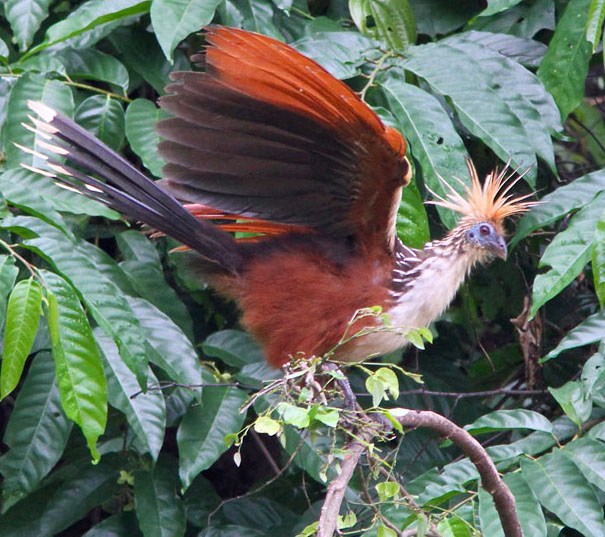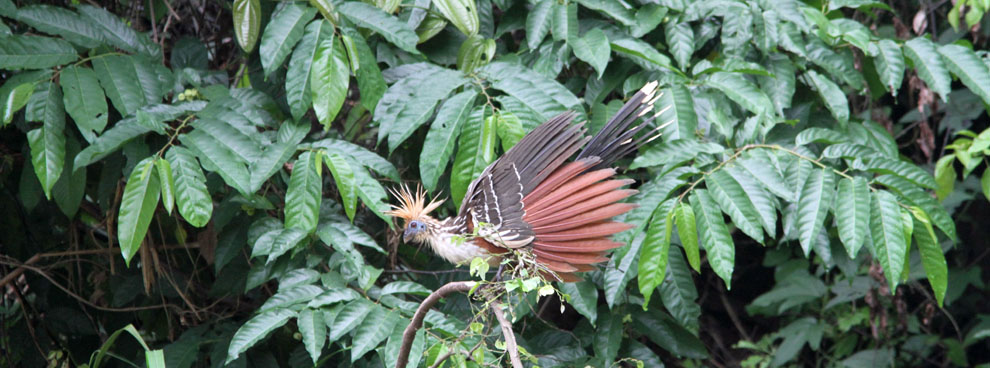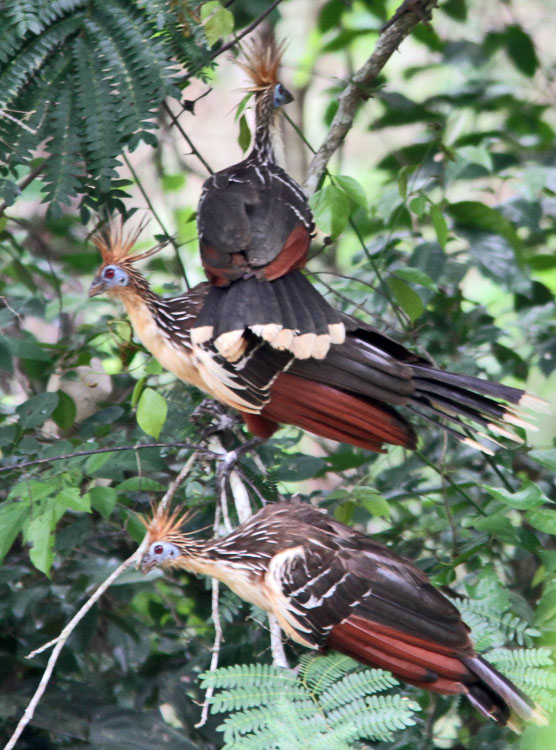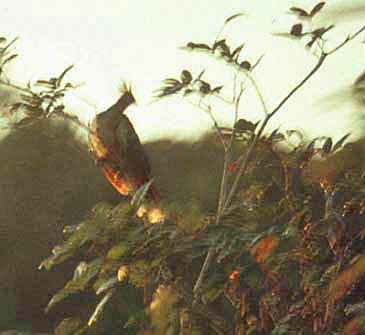| |
HOATZIN Opisthocomidae |
- 1 species in tropical South America
- DR personal total: 1 species (100%), 1 photo'd
|
 The Hoatzin is a very odd bird that lives in backwater swamps of the Amazon and Orinoco basins of South America. It is once considered one of the most primitive of birds. Its odd pear-like shape, bare face, shaggy crest, and behaviors are, indeed, unusual. It is actually an ancient lineage of uncertain affinities — and assigned to its own Order — but is not necessarily as "primitive" as was once thought. For example, hoatzins have anisodactyl feet (three toes forward, one backwards) — like most birds — rather than the zygodactyl feet (two toes forward, two backward) shown by such long-extant families, such as cuckoos. The Hoatzin is a very odd bird that lives in backwater swamps of the Amazon and Orinoco basins of South America. It is once considered one of the most primitive of birds. Its odd pear-like shape, bare face, shaggy crest, and behaviors are, indeed, unusual. It is actually an ancient lineage of uncertain affinities — and assigned to its own Order — but is not necessarily as "primitive" as was once thought. For example, hoatzins have anisodactyl feet (three toes forward, one backwards) — like most birds — rather than the zygodactyl feet (two toes forward, two backward) shown by such long-extant families, such as cuckoos.
The Hoatzin chick features a rare anatomical feature: two claws on each budding wing which help it grip branches and clamber about awkwardly. This feature has been compared to Archaeopteryx, the fossil proto-bird, and lends a antediluvian background to what is already a really weird bird [fantastic video of adult and young Hoatzin are in David Attenborough's "Life of Birds" and "Life on Earth" series]. |
 |
The Hoatzin is in its own Order [Opisthocomiformes], and the placement of that Order in the linear sequence of Orders is still uncertain. The relationship of Hoatzin to other bird families has been the subject of much debate over the years. They have variously been grouped with the cranes, rails, tinamous, sandgrouse, doves, mousebirds or seriemas. Even molecular evidence has not yet produced a firm answer. To quote a taxonomic note in the Classification of the Bird Species of South America authored by the South American Classification Committee:
"The placement of this order is highly controversial. ... Some genetic data have indicated that it is closely related to the Cuculiformes (Sibley & Ahlquist 1990) or Musophagiformes (Hughes & Baker 1999). De Queiroz and Good (1988), Mayr & Clarke (2003), and Livezey & Zusi (2007) found morphological evidence consistent with its placement near Cuculiformes or Musophagiformes. However, a recent genetic data set (Sorenson et al. 2003) failed to find support for a relationship to any of these groups, but found weak support for a relationship to the Columbiformes. Other genetic data (Fain & Houde 2004, Ericson et al. 2006) also suggest that Opisthocomus is perhaps a member of a group of orders that also includes the Columbiformes. However, the most comprehensive genetic data set (Hackett et al. 2008) was unable to resolve its relationships, with no evidence for close relationship to any order within the Neoaves. Jarvis et al. (2014) found weak support for it as sister to Charadriiformes + Gruiformes. In contrast, Prum et al. (2015) found that it was the basal member of a group of lineages that includes all other landbird lineages."
|

Hoatzins live in family groups and small aggregations (up to 40 birds) and are social throughout the year. During breeding birds occupy densely packed exclusive territories, sometimes up to 28 nests in one tree. They are noisy and often vocalize in unison with a collection of hoarse cries, grunts, growls and hisses.
Hoatzins are limited to their lowland swamp habitat. Old cut-off river channels and backwater lagoons are appropriate, but they avoid swift-moving water. Thus in many riverine places in South America, Hoatzins will be found only in a few well-known places. Many jungle lodges will offer boat trips to see Hoatzins although in some places (like La Selva Lodge, Ecuador) they are right at the main boat dock. Hoatzins are poor fliers, and they put a lot of noisy effort into using their broad rusty wings to cross channels or move away from perceived danger.
Hoatzins are strictly vegetarian, eating the leaves, flowers and fruits of more than 50 species of marshland plants. It is unique among birds, however, because they ferment this vegetable matter in their foregut like cows, sheep, deer and kangaroos, and thus have a specialized digestive system. Nestlings are fed this regurgitated matter. Hoatzins forage in the early morning and early evening, and spend much of the time roosting quietly and digesting their meal. |

During my own early trips to South America — before digital photography — I found Hoatzins to be difficult birds to photograph in the dark, dank air of a muggy swamp, amid the whine of hundreds of mosquitoes. Back then I could not manage much more than a blurry, enigmatic, watercolor image of a Hoatzin at dawn (right). Thankfully, digital cameras help overcome the obstacles.
This is surely one species that visitors will want to see. Whatever its affinities may be, these are unique and impressive birds, well deserving of the attention showered on them by visiting birdwatchers to South America. |
| |
Photos: All but the final photo of Hoatzin Opisthocomus hoazin were taken at Bosque de Quinilla, San Martín, Peru, on 15 Nov 2014. The "hoatzin-at-dawn" was at the Tambopata Nature Reserve, Madre de Dios, Peru, in June 1987.
All photos © Don Roberson; all rights reserved.
Bibliographic note: There is no "family book" but a fine introduction to this family, with some excellent photos, is in Thomas (1996).
Literature cited:
De Queiroz, K., and D.A. Good. 1988. The scleral ossicles of Opisthocomus and their phylogenetic significance. Auk 105: 29–35.
Ericson, P.G.P., C.L. Anderson, T. Britton, A. Elzanowski, U.S. Johansson, M. Källersjö, J.I. Ohlson, T.J. Parsons, D. Zuccon, and G. Mayr. 2006. Diversification of Neonaves: integration of molecular sequence data and fossils. Biol. Letters 2: 543–547.
Fain, M. G., and P. Houde. 2004. Parallel radiations in the primary clades of birds. Evolution 58: 2558–2573.
Hackett, S.J., R.T. Kimball, S. Reddy, R.C.K. Bowie, E.L. Braun, M.J. Braun, J.L. Chojnowski, W.A. Cox, K. Han, J. Harshman, C.J. Huddleston, B.D. Marks, K.L. Miglia, W.S. Moore, F.H. Sheldon, D.W. Steadman, C.C. Witt, and T. Yuri. 2008. A phylogenomic study of birds reveals their evolutionary history. Science 320: 1763–1768.
Hughes, J.M., and A J. Baker. 1999. Phylogenetic relationships of the enigmatic Hoatzin (Opisthocomus hoazin) resolved using mitochondrial and nuclear gene sequences. Molec. Biol. Evol. 16: 1300–1307.
Jarvis, E.D., S. Mirarab, A.J. Aberer, B. Li, P. Houde, C. Li, S.Y.W. Ho, B.C. Faircloth, B. Nabholz, J.T. Howard, A. Suh, C.C. Weber, R.R. da Fonseca, J. Li, F. Zhang, H. Li, L. Zhou, N. Narula, L. Liu, G. Ganapathy, B. Boussau, M.S. Bayzid, V. Zavidovych, S. Subramanian, T. Gabaldón, S. Capella-Gutiérrez, Jaime Huerta-Cepas 19 , Bhanu Rekepalli 20 , K. Munch, M. Schierup, B. Lindow, W.C. Warren, D. Ray, R.E. Green, M.W, Bruford, X. Zhan, A. Dixon, S. Li, N. Li, Y. Huang, E.P. Derryberry, M.F. Bertelsen, F.H. Sheldon, R.T. Brumfield 32 , C.V. Mello, P.V. Lovell, M. Wirthlin, M.P.C. Schneider, F. Prosdocimi, J.A. Samaniego, A.M.V. Velazquz, A. Alfaro-Núñe, P.F. Campos, B. Petersen, T. Sicheritz-Ponten, A. Pas, T. Bailey, P. Scofield, M. Bunce, D.M. Lambert, Q. Zhou, P. Perelman, A.C. Driskell, B. Shapiro, Z. Xiong, Y. Zeng, S. Liu, Z. Li , B. Liu , K.Wu, J. Xiao, X. Yinqi, Q. Zheng, Y. Zhang, H. Yang, J. Wang, L. Smeds, F.E. Rheindt, M. Braun, J. Fjeldsa, L. Orlando, F.K. Barker, K.A. Jønsson, W. Johnson, K-P. Koepfli, S. O'Brien, D. Haussler, O.A. Ryder, C. Rahbek, E. Willerslev, G.R. Graves, T.C. Glenn, J. McCormack, D. Burt, H. Ellegren, P. Alström, S.V. Edwards, A. Stamatakis, D.P. Mindell, J. Cracraft, E.L. Braun, T. Warnow, W. Jun, M.T.P. Gilbert, G. Zhang. 2014. Whole-genome analyses resolve early branches in the tree of life of modern birds. Science 346: 1320–1331.
Livezey, B.C., and R. L. Zusi. 2007. Higher-order phylogeny of modern birds (Theropoda, Aves: Neornithes) based on comparative anatomy. II. Analysis and discussion. Zool. J. Linnean Soc. 149: 1–95.
Mayr, G., and J. Clarke. 2003. The deep divergences of neornithine birds: a phylogenetic analysis of morphological characters. Cladistics 19: 527–553.
Prum, R.O., J.S. Berv, A. Dornburg, D.J. Field, J.P. Towensend, E.M. Lemon, and A.R. Lemmon. 2015. A comprehensive phylogeny of birds (Aves) using targeted next-generation DNA sequencing. Nature 526: 569–573.
Sibley, C.G., and J.E. Ahlquist. 1990. Phylogeny and Classification of Birds: a Study of Molecular Evolution. Yale Univ. Press, New Haven, CT.
Sorenson, M. D., E. O'Neal, J. Garcia-Moreno, and D.P. Mindell. 2003. More taxa, more characters: the Hoatzin problem is still unresolved. Molec. Biol. Evol. 20: 1484-1498.
Thomas, B.T. 1996. Family Opisthocomidae (Hoatzin), pp. 24–32 in Handbook of the Birds of the World (del Hoyo, J., A. Elliott & J. Sargatal, eds). Vol. 3. Lynx Edicions, Barcelona, Spain.
|
|
|


 The Hoatzin is a very odd bird that lives in backwater swamps of the Amazon and Orinoco basins of South America. It is once considered one of the most primitive of birds. Its odd pear-like shape, bare face, shaggy crest, and behaviors are, indeed, unusual. It is actually an ancient lineage of uncertain affinities — and assigned to its own Order — but is not necessarily as "primitive" as was once thought. For example, hoatzins have anisodactyl feet (three toes forward, one backwards) — like most birds — rather than the zygodactyl feet (two toes forward, two backward) shown by such long-extant families, such as cuckoos.
The Hoatzin is a very odd bird that lives in backwater swamps of the Amazon and Orinoco basins of South America. It is once considered one of the most primitive of birds. Its odd pear-like shape, bare face, shaggy crest, and behaviors are, indeed, unusual. It is actually an ancient lineage of uncertain affinities — and assigned to its own Order — but is not necessarily as "primitive" as was once thought. For example, hoatzins have anisodactyl feet (three toes forward, one backwards) — like most birds — rather than the zygodactyl feet (two toes forward, two backward) shown by such long-extant families, such as cuckoos.
